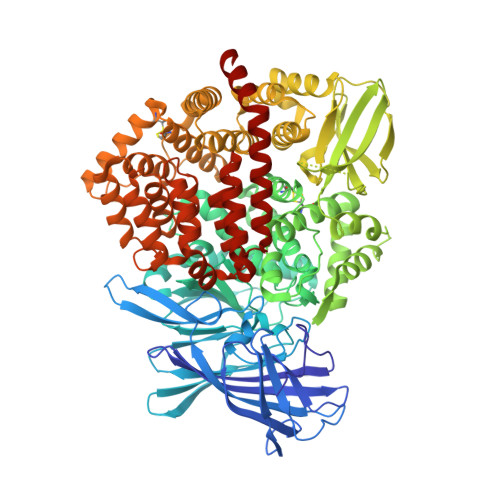Discovery of Selective Nanomolar Inhibitors for Insulin-Regulated Aminopeptidase Based on alpha-Hydroxy-beta-amino Acid Derivatives of Bestatin.
Vourloumis, D., Mavridis, I., Athanasoulis, A., Temponeras, I., Koumantou, D., Giastas, P., Mpakali, A., Magrioti, V., Leib, J., van Endert, P., Stratikos, E., Papakyriakou, A.(2022) J Med Chem 65: 10098-10117
- PubMed: 35833347
- DOI: https://doi.org/10.1021/acs.jmedchem.2c00904
- Primary Citation of Related Structures:
7Z28, 7ZYF - PubMed Abstract:
The oxytocinase subfamily of M1 zinc aminopeptidases comprises emerging drug targets, including the ER-resident aminopeptidases 1 and 2 (ERAP1 and ERAP2) and insulin-regulated aminopeptidase (IRAP); however, reports on clinically relevant inhibitors are limited. Here we report a new synthetic approach of high diastereo- and regioselectivity for functionalization of the α-hydroxy-β-amino acid scaffold of bestatin. Stereochemistry and mechanism of inhibition were investigated by a high-resolution X-ray crystal structure of ERAP1 in complex with a micromolar inhibitor. By exploring the P1 side-chain functionalities, we achieve significant potency and selectivity, and we report a cell-active, low-nanomolar inhibitor of IRAP with >120-fold selectivity over homologous enzymes. X-ray crystallographic analysis of IRAP in complex with this inhibitor suggest that interactions with the GAMEN loop is an unappreciated key determinant for potency and selectivity. Overall, our results suggest that α-hydroxy-β-amino acid derivatives may constitute useful chemical tools and drug leads for this group of aminopeptidases.
- National Centre for Scientific Research "Demokritos", Ag. Paraskevi, GR-15341 Athens, Greece.
Organizational Affiliation:























